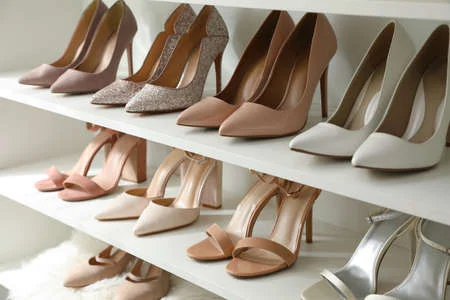Organizing shoes can be a daunting task. There always seem to be more pairs than
space to store them. Extras frequently end up in piles on the closet floor, or lined up
underneath the hanging clothes where they’re impossible to see and difficult to reach.
Consider these options for storing your shoes. Mix and match them for your perfect
solution.
- Over the door hanging pockets allow for easy access, especially if bending or
reaching is difficult. They’re best for storing shoes that aren’t too bulky or heavy,
like flip flops or flat sandals. Using the door for additional storage maximizes
limited space. Plus, they’re inexpensive and easy to hang.
Floor-based options
- Floor-based shoe racks are probably the most versatile option. You can choose a
low, single shelf, or ones with two or more levels, depending on your available
space. - Shoe racks that expand and contract in length.
- Some have angled surfaces, others are flat.
- Options with solid or mesh surface, made from wood, metal or plastic to suit your
taste. - One type of rack consists of two bars at different levels, designed for hanging
women’s heels. Personally, I prefer level surfaces because they accommodate
all types of shoes, regardless of whether they’re heels, flats or wedges. - Particle board “cubbies” are another option if you’re comfortable with some
moderate assembly. Since the compartments tend to be small you may have to
store one shoe in each, so be sure to determine beforehand how many pairs this
method will accommodate. These are stackable so you may use more than one if
you have the wall space available.
Built-ins
- Built-in shelving is great because of the visibility it offers. Using the most
accessible shelves for the most frequently worn shoes, (think of the space
between your hips and your shoulders as the “prime” space), will save you from
excessive bending and reaching. - Sometimes, with built ins, there’s too much space left above a pair of shoes, so if
the shelves are adjustable, you can move them closer together. Or use the taller
shelves for boots and high-heals. Another option is to stack two boxes, one on
top of another to fill the space.
Stackables
- The Container Store’s see-through stacking drawers are one of my favorite ways
to store shoes. They combine the benefits of stacking multiple pairs without
having to move boxes around, the ability to see what’s inside each box,
protection from dust and dirt, and they can be used on the floor, on shelves
above your hanging clothes, or stacked in your built-ins. They come in different
sizes so you can choose which is best for the shoes you have. This option tends
to be a little more expensive, but the benefits may outweigh the cost in the long
run. - I also like IKEA’s SCUBB shoe boxes. They fold flat when not needed and are
very inexpensive. They look clean and fresh and they can hold the weight of a
second box on top without crushing.
Under the bed storage
- Under the bed shoe storage can be a life saver if you’re seriously challenged for
closet space. This option is best for shoes that are infrequently worn. Just be
sure you’re physically able to reach and replace them. Also, beware the adage
“out of sight, out of mind”.
Other considerations when storing footwear:
- separate by season
- keep shoes worn regularly in the most convenient location. If certain shoes get
dirty or are worn daily, it might make sense to store them on a shoe rack in an
entry closet, mud room, or garage. - store dressy and special occasion shoes on upper shelves, saving prime lower
space for other shoes - If you have plenty of space on your upper shelves you can stand boots up, but
you will want to put tissue paper or boot shapers made specifically for that
purpose inside, to keep them standing upright - If your shelf space is limited but your hanging space is greater, then hang your
boots from special boot hangers. - label shoe boxes, or take pictures of the shoes and attach them to the box
Creative ways for maximizing space.
I often store flip flops and other flat sandals back-to-back, then line them up on their
sides, almost resembling books on a shelf. Placing the heel of one shoe against the toe
of the other is another way to fit more pairs per shelf. It also helps identify which shoes
are which.
Toes facing in or out? Whichever you prefer. When lining up high heels or wedges
sometimes you can fit more per shelf by having one shoe with the heel facing out, and
the other with the toe facing out. I also like this method because it’s easier to identify
the pair this way. If all I see are heels, I may not know which pair I’m looking at.
Try stacking shoes on top of each other if they’re fairly flat and won’t fall over easily. To
avoid getting shoes dirty, stack them with the tops against each other, heel to toe.
If you have designer shoes you no longer wear, and they’re in near-perfect condition,
you can bring them to a consignment shop and recoup some of your investment.
One final note. Before implementing any of these suggestions, discard your worn-out
shoes and donate the pairs you never wear. Hint. You’ll know which ones they are
because they’ll be covered with dust!

